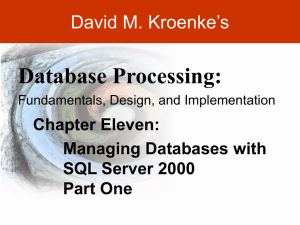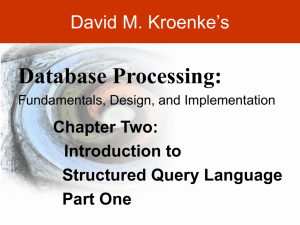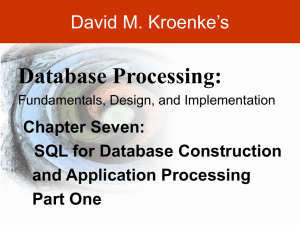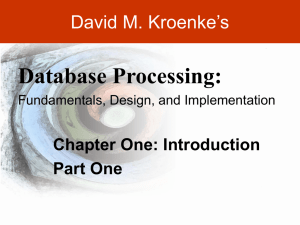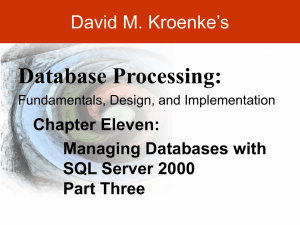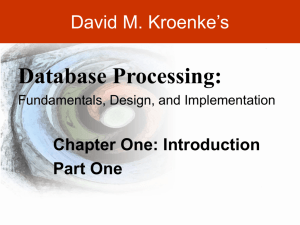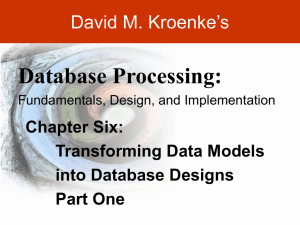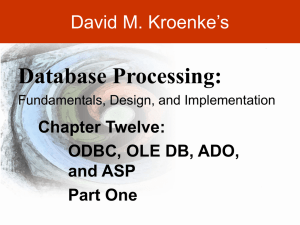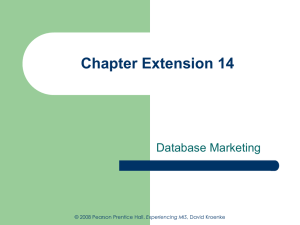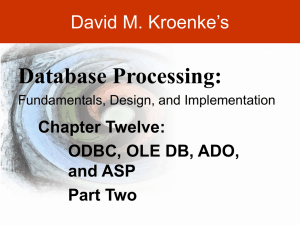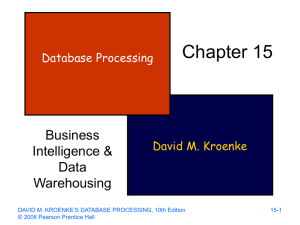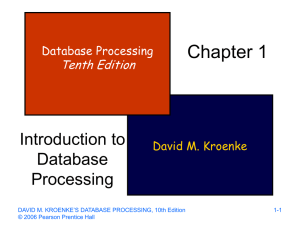Kroenke-DBP-e10-PPT-Chapter07
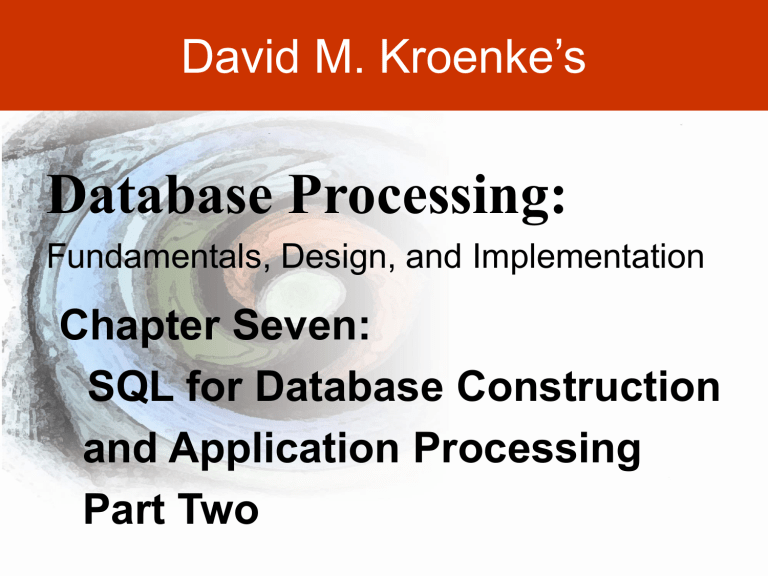
David M. Kroenke’s
Database Processing:
Fundamentals, Design, and Implementation
Chapter Seven:
SQL for Database Construction and Application Processing
Part Two
DAVID M. KROENKE’S DATABASE PROCESSING, 10th Edition
© 2006 Pearson Prentice Hall
7-1
SQL DML: UPDATE
• UPDATE command:
UPDATE CUSTOMER
SET City = 'New York City'
WHERE CustomerID = 1000;
• Bulk UPDATE:
UPDATE CUSTOMER
SET AreaCode = '333'
WHERE City = 'Denver';
DAVID M. KROENKE’S DATABASE PROCESSING, 10th Edition
© 2006 Pearson Prentice Hall
7-2
SQL DML: DELETE
• DELETE command:
DELETE FROM CUSTOMER
WHERE CustomerID = 1000;
• If you omit the WHERE clause, you will delete every row in the table!
DAVID M. KROENKE’S DATABASE PROCESSING, 10th Edition
© 2006 Pearson Prentice Hall
7-3
JOIN ON Syntax
• JOIN ON syntax:
SELECT CUSTOMER.Name, ARTIST.Name
FROM
ON
CUSTOMER JOIN CUSTOMER_ARTIST_INT
CUSTOMER.CustomerID =
CUSTOMER_ARTIST_INT.CustomerID
JOIN ARTIST
ON CUSTOMER_ARTIST_INT.ArtistID =
ARTIST.ArtistID;
• Use of aliases:
SELECT C.Name, A.Name
FROM
ON
CUSTOMER AS C JOIN CUSTOMER_ARTIST_INT AS CI
C.CustomerID = CI.CustomerID
JOIN ARTIST AS A
ON CI.ArtistID = A.ArtistID;
DAVID M. KROENKE’S DATABASE PROCESSING, 10th Edition
© 2006 Pearson Prentice Hall
7-4
DAVID M. KROENKE’S DATABASE PROCESSING, 10th Edition
© 2006 Pearson Prentice Hall
7-5
Outer Joins
• Left Outer Join:
SELECT C.[Name] Customer, A.[Name] Artist
FROM
ON
CUSTOMER C LEFT JOIN CUSTOMER_ARTIST_INT CI
C.CustomerID = CI.CustomerID
LEFT JOIN ARTIST A
ON CI.ArtistID = A.ArtistID;
DAVID M. KROENKE’S DATABASE PROCESSING, 10th Edition
© 2006 Pearson Prentice Hall
7-6
Result of Outer Join
DAVID M. KROENKE’S DATABASE PROCESSING, 10th Edition
© 2006 Pearson Prentice Hall
7-7
SQL Views
• SQL view is a virtual table that is constructed from other tables or views
• It has no data of its own, but obtains data from tables or other views
• SELECT statements are used to define views
– A view definition may not include an ORDER BY clause
• SQL views are a subset of the external views
– They can be used only for external views that involve one multivalued path through the schema
DAVID M. KROENKE’S DATABASE PROCESSING, 10th Edition
© 2006 Pearson Prentice Hall
7-8
SQL Views
DAVID M. KROENKE’S DATABASE PROCESSING, 10th Edition
© 2006 Pearson Prentice Hall
7-9
CREATE VIEW Command
• CREATE VIEW command:
CREATE VIEW CustomerNameView AS
SELECT [Name] AS CustomerName
FROM CUSTOMER;
• To see the view use:
SELECT *
FROM CustomerNameView
ORDER BY CustomerName;
• Results:
DAVID M. KROENKE’S DATABASE PROCESSING, 10th Edition
© 2006 Pearson Prentice Hall
7-10
Updateable Views
DAVID M. KROENKE’S DATABASE PROCESSING, 10th Edition
© 2006 Pearson Prentice Hall
7-11
Embedding SQL In Program Code
• SQL can be embedded in triggers, stored procedures, and program code
• Problem: assigning SQL table columns with program variables
• Solution: object-oriented programming, PL/SQL
• Problem: paradigm mismatch between SQL and application programming language
– SQL statements return sets of rows; an applications work on one row at a time
• Solution: process the SQL results as pseudofiles
DAVID M. KROENKE’S DATABASE PROCESSING, 10th Edition
© 2006 Pearson Prentice Hall
7-12
Triggers
• A trigger is a stored program that is executed by the
DBMS whenever a specified event occurs on a specified table or view
• Three trigger types:
BEFORE, INSTEAD OF , and AFTER
– Each type can be declared for Insert, Update, and Delete
– Resulting in a total of nine trigger types
• Oracle supports all nine trigger types
• SQL Server supports six trigger types (only for INSTEAD
OF and AFTER triggers)
DAVID M. KROENKE’S DATABASE PROCESSING, 10th Edition
© 2006 Pearson Prentice Hall
7-13
Firing Triggers
• When a trigger is fired, the DBMS supplies:
– Old and new values for the update
– New values for inserts
– Old values for deletions
• The way the values are supplied depends on the
DBMS product
• Trigger applications:
– Provide default values
– Enforce data constraints
– Update views
– Perform referential integrity actions
DAVID M. KROENKE’S DATABASE PROCESSING, 10th Edition
© 2006 Pearson Prentice Hall
7-14
DAVID M. KROENKE’S DATABASE PROCESSING, 10th Edition
© 2006 Pearson Prentice Hall
7-15
DAVID M. KROENKE’S DATABASE PROCESSING, 10th Edition
© 2006 Pearson Prentice Hall
7-16
Stored Procedures
• A stored procedure is a program that is stored within the database and is compiled when used
– In Oracle, it can be written in PL/SQL or Java
– In SQL Server, it can be written in TRANSACT-SQL
• Stored procedures can receive input parameters and they can return results
• Stored procedures can be called from:
– Programs written in standard languages, e.g., Java, C#
– Scripting languages, e.g., JavaScript, VBScript
– SQL command prompt, e.g., SQL*Plus, Query Analyzer
DAVID M. KROENKE’S DATABASE PROCESSING, 10th Edition
© 2006 Pearson Prentice Hall
7-17
Stored Procedure Advantages
• Greater security as store procedures are always stored on the database server
• Decreased network traffic
• SQL can be optimized by the DBMS compiler
• Code sharing resulting in:
– Less work
– Standardized processing
– Specialization among developers
DAVID M. KROENKE’S DATABASE PROCESSING, 10th Edition
© 2006 Pearson Prentice Hall
7-18
DAVID M. KROENKE’S DATABASE PROCESSING, 10th Edition
© 2006 Pearson Prentice Hall
7-19
Triggers vs. Stored Procedures
DAVID M. KROENKE’S DATABASE PROCESSING, 10th Edition
© 2006 Pearson Prentice Hall
7-20
David M. Kroenke’s
Database Processing
Fundamentals, Design, and Implementation
(10 th Edition)
End of Presentation:
Chapter Seven Part Two
DAVID M. KROENKE’S DATABASE PROCESSING, 10th Edition
© 2006 Pearson Prentice Hall
7-21
